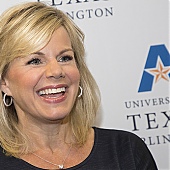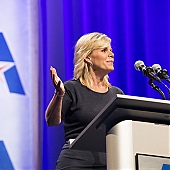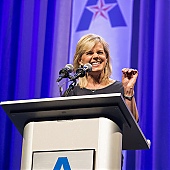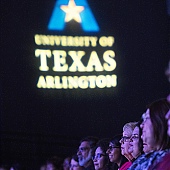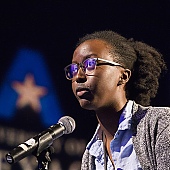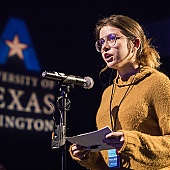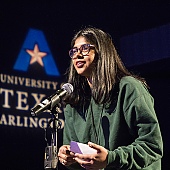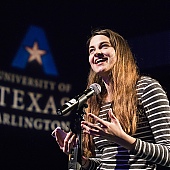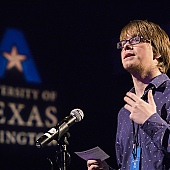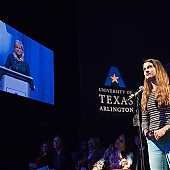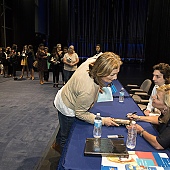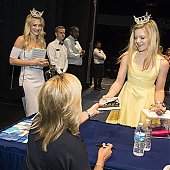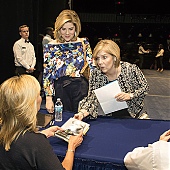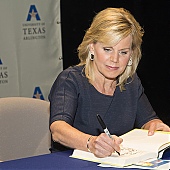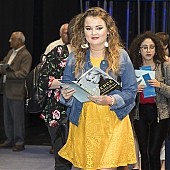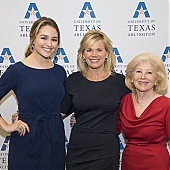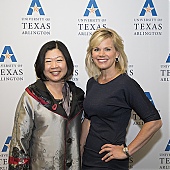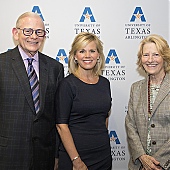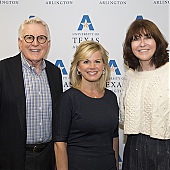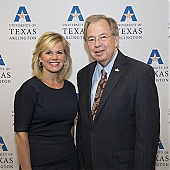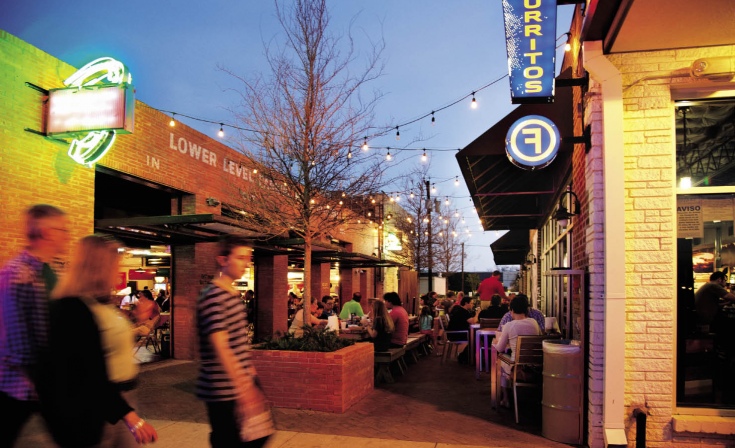
Deep in the Heart of Arlington
University and city leaders shared a vision of transforming downtown into a dining and entertainment destination. The result: a revitalized corridor featuring restaurants, performance venues, nightlife, and a rising cool factor.
· Spring 2013 · Comment ·
Along Abram Street a courtyard with picnic tables beckons between Freebirds World Burrito and Twisted Root Burger Co. Next door the newly reimagined Hooligan’s presents a stylish and casual bar with beautiful woodgrain touches, a stone fireplace, and a cozy patio. A few steps around the corner you’ll find old favorite J. Gilligan’s still serving cold beer and heaps of Irish nachos. Behind Gilligan’s the trendy Capital Bar has transformed an old Goodyear building.
Little of this was here a few years ago: the restaurants, the people, the cars parked along South Street because the nearby lots are full. Hard to believe. Downtown Arlington is bustling, and people are talking.
Architecture alumnus Homer Saenz takes his family downtown at least once a week. “It’s nice to have a place to go out with your friends, enjoy some live music and things that we haven’t had before,” he says. “We’ve always had to go to Fort Worth or Dallas to do that. I really like what’s going on down there.”
MIDDLE OF SOMEWHERE
“It’s a comfort knowing we have a downtown that’s growing and vibrant and will continue to grow and become a fun place for people.”
South Arlington may be a hub for shoppers with The Parks at Arlington mall and Arlington Highlands, and north Arlington is a sports fans’ paradise with Rangers Ballpark, Cowboys Stadium, and abundant sports bars. But downtown has found its niche, too—eclectic dining, entertainment, cultural events. Forget north and south. The place to be is right in the middle.
Downtown wasn’t always a big deal. “It was terrible,” alumna Patti Diou, executive director of Friends of the Levitt Pavilion, recalls of her time as a UT Arlington student. “It wasn’t a downtown. There was nothing.”
Efforts to improve the area began a couple of decades ago and gained steam in 2006. The result has been a burst of development and interest.
UT Arlington has fueled downtown’s resurgence. President James D. Spaniolo sought for Arlington a college town atmosphere, so the University partnered with the city to establish the Downtown Arlington Management Corp. The two provided initial funding, then the city established a business improvement district to subsidize the support. The district taxes 400 properties within the downtown boundaries, approximately 15 cents per $100 in valuation.
Around that time, the Levitt Pavilion was rising across from City Hall in a land swap with the First Baptist Church. The outdoor performance venue was a collaborative venture involving the Downtown Arlington Management Corp., city of Arlington, Chamber of Commerce, and the University.
UT Arlington’s ambitious College Park District all by itself takes downtown to another level, adding numerous restaurants and the 7,000-seat College Park Center events venue. Diners can frequent Pie Five Pizza Co., Coolberry Frozen Yogurt, Smiling Moose Deli, Digg’s Taco Shop, Pho Xpress, Grip Mediterranean Grill, and Blaze’s Sports Grill.
Nor is College Park just for students, something locked deep within the campus, but a 20-acre residential and retail montage that blurs the boundaries between the city and the University, inviting everyone to visit.
MAKING THE SCENE
The bustling nightlife in downtown Arlington includes live music at the Grease Monkey Burger Shop and Social Club, popular restaurants like the Flying Fish, and performances at the recently renovated Arlington Music Hall.
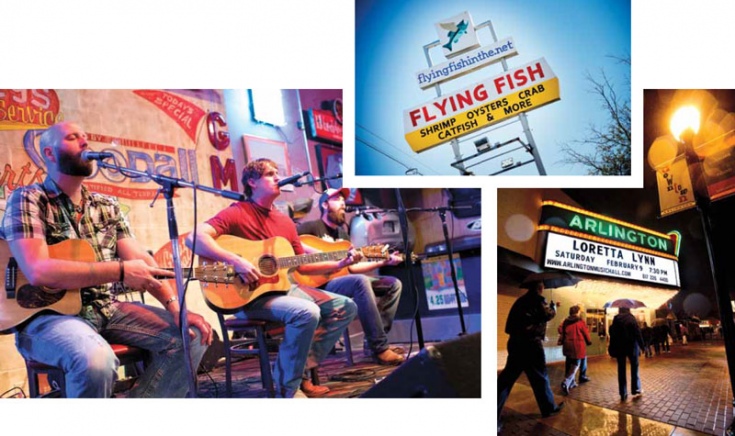
EAT, LISTEN, ENJOY
All this buzz reflects a national trend, a shift in perspective that again makes downtown crucial to a city’s identity.
“Every city needs a downtown,” says Diou ’86. “They moved away from it, and now everyone is going back to it. It’s a comfort knowing we have a downtown that’s growing and vibrant and will continue to grow and become a fun place for people.”
The restaurant boom has been most noticeable. Since 2006 Arlington has welcomed, among others, Mavericks Bar and Grill, Old School Pizza and Subs, Fuzzy’s Taco Shop, Flying Fish, Mellow Mushroom, Babe’s Chicken Dinner House, and Potager. Alumnus Greg Gardner ’91, managing partner of the Grease Monkey Burger Shop and Social Club, appreciates downtown’s one-of-a-kind vibe.
“It’s got a uniqueness to it. It doesn’t feel strip mall-ish or overrun with franchise-type businesses. There’s a sprinkle of local originality. I hope to see that grow.
“People always ask me, ‘Are you worried about these places going in?’ Oh my gosh, I’m like, ‘The more, the merrier.’ The only way this is going to truly be a place for people to come and hang out, park their car, and walk around is if you’ve got multiple places and different types of venues and shops and restaurants.”
Some eateries offer more than food and drink. Capital Bar and Gilligan’s regularly host bands. Grease Monkey has live music five nights a week, including a UTA Jazz Band ensemble the last Monday of the month.
Arlington Music Hall, which underwent a $7 million renovation, is showcasing the likes of Willie Nelson, Loretta Lynn, and Merle Haggard. The Levitt Pavilion provides 50 free concerts a year.
“When we started, we really wanted to have at least 500 people on the lawn,” the Levitt’s Diou says. “Now we’re disappointed when there’s not 2,000 people. We’ve been thrilled. Our audience last year hit over 100,000 people.”
DOWNTOWN DISCOURSE
Housing may be the linchpin to downtown maintaining its growth, with potential demand coming from 33,800 students and the University’s nearly 4,000 employees. About 6,000 students live on or within a mile of campus, and the City Council recently approved rezoning for a five-story apartment community catering to professionals, particularly UT Arlington faculty and staff.
“The growing trend to build more housing is extremely important because it drives traffic and excitement downtown,” says Tony Rutigliano, president and CEO of the Downtown Arlington Management Corp.
Rutigliano would like to see more multifamily residences in central Arlington, but the challenge is building them at a higher value. Typically, apartments go for 80 cents a square foot; he envisions $1.50.
“Anecdotally, I hear a lot of people saying, ‘Hey, I graduated from UTA and I’m ready to stay here and work and do things,’ ” he says. “We need to help them by providing housing opportunities.”
Beyond housing, the Downtown Arlington Management Corp. makes a case for a new approach to streets. Bond funding will address Abram Street from Cooper to Collins in 2015.
“I expect we’ll be working with the city over the next year or so on the design,” Rutigliano says. “I’m hopeful that the project will be pedestrian oriented.”
Abram Street is crucial to downtown’s continued redevelopment and momentum.
“We’ve got to reverse our mindset. Arlington was developed around the car, but we now have the opportunity to redevelop downtown Arlington around the pedestrian. It’s a once-in-a-generation opportunity. We need people to come downtown on Abram Street and have that be a destination street. Get here, stay here, park here, walk.”
As Arlington and its citizens mull how to improve downtown, its ultimate look will evolve. Arlington is not Dallas or Fort Worth, with their looming skylines, but it doesn’t bear the expectations of its large neighbors, either. Like Austin, Arlington’s downtown depends on its university. Unlike Austin, Arlington doesn’t suffer the “curse of Sixth Street”—a college bar scene so frenetic and volatile that locals stay away.
Will Arlington imitate Grapevine with its quaint, walkable downtown, or maybe the Depot Entertainment District in Lubbock with its historical buildings, live music, and sports bars on Buddy Holly Avenue? Comparisons aside, at least downtown is part of the conversation—and the talk is growing louder.
For Saenz ’93, an architect with Freese and Nichols and a 25-year Arlington resident, downtown’s dynamic scene offers the perfect mix.
“There are so many options. You can eat dinner with the family or listen to live music at the different bars. You don’t have to haul all the way to Fort Worth or Dallas. It’s a great place to hang out, and it’s close to home.”
Close to remarkable, actually.
